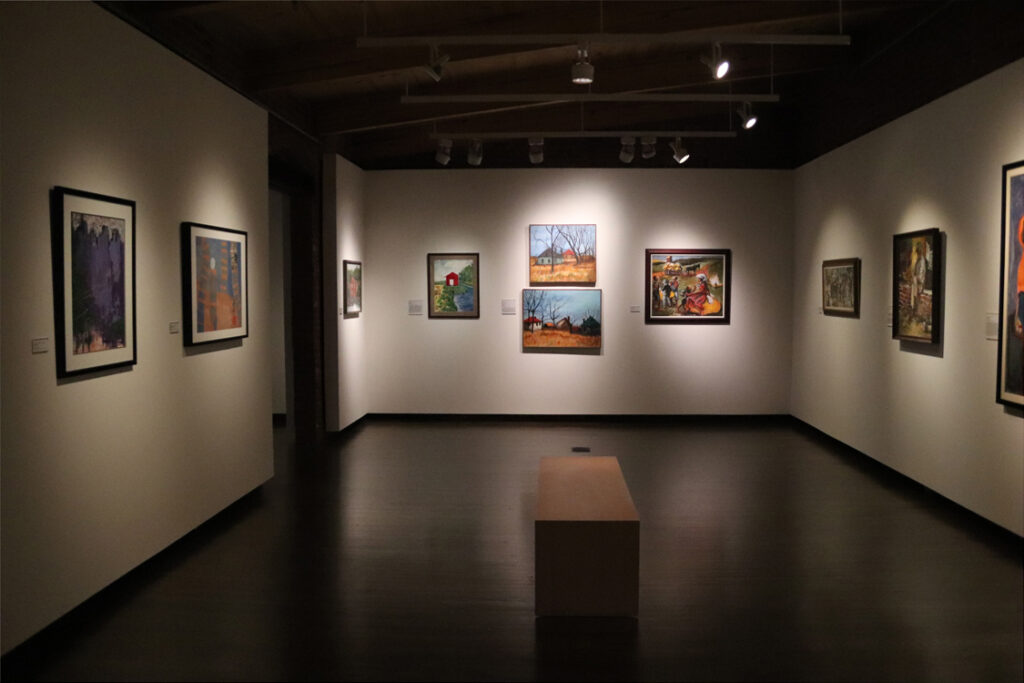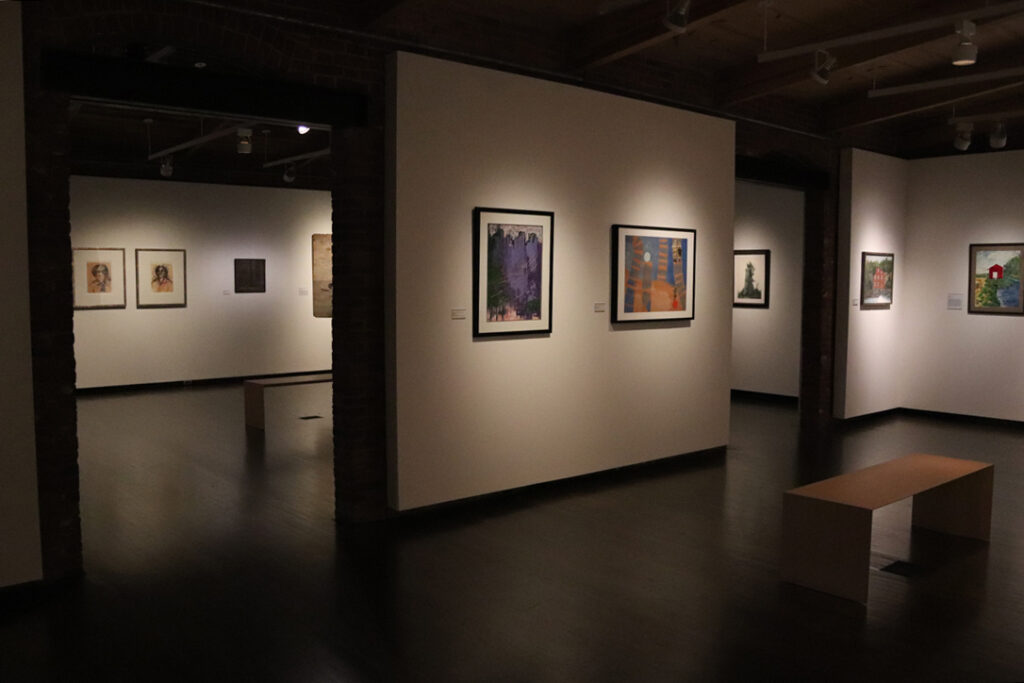






22.
Edwin Augustus Harleston (1882 – 1931)
Mr. Rozen
1920
gouache on paper
Museums Collections, Gift of Paul R. Jones
This little seascape is a rare example of Edwin Harleston’s work outside of portraiture, the genre for which he is best known. Described by W.E.B. Du Bois as the “leading portrait painter of the race,” Harleston devoted his artistic efforts to creating dignified portraits of African Americans in his hometown of Charleston, South Carolina. Harleston was born in segregated Charleston to a prominent Black family, and attended Atlanta University, the School of the Museum of Fine Arts in Boston and the School of the Art Institute of Chicago. Pressured by his father to work at the family funeral home, Harleston returned to the South in 1912. With the support of his wife, Elise (herself a photographer), Harleston continued to pursue art, though racial prejudices prevented him from receiving several high profile commissions. Constrained by both racial barriers and family obligations, Harleston was thus never able to fully devote himself to art. In a letter to Elise, Harleston explained that he strove to portray African Americans, “in our varied lives and types with the classic technique and the truth, not caricatures.”
23.
Charles D. Rogers (1900 – 1999)
Canyons
1993
acrylic on paper
Museums Collections, Gift of Paul R. Jones
24.
Tai Tennyson (unknown)
Kids Playing
1982
mixed media and collage
Museums Collections, Gift of Paul R. Jones
25.
Ted Davis (1908 – 1995)
Red Mill
1977
acrylic on canvasboard
Museums Collections, Gift of Paul R. Jones
26.
Rex Goreleigh (1902 – 1986)
Red Barn
1981
watercolor on paper
Museums Collections, Gift of Paul R. Jones
Rex Goreleigh, born in Penllyn, Pennsylvania, was inspired to become an artist while working as a waiter in New York City. In 1933, Goreleigh waited on the table of Mexican artist Diego Rivera, and was invited to observe the artist as he worked on the murals at Rockefeller Center. Goreleigh later said that this experience “put him on the road to becoming an artist.” Goreleigh received his artistic training at the Art Students League in New York, and later, at the André Lhote Académie in Paris. In the 1930s, he taught at the Harlem Community Art Center in New York. After stints teaching in Greensboro, North Carolina and Chicago, Goreleigh settled in Princeton, New Jersey in 1947. There, he established a home and studio in a restored mill that he called Studio-on-the-Canal. Throughout his career as a teacher, Goreleigh continued his practice of painting, and is best known for a series of works depicting migrant farm workers in rural New Jersey.





27.
Truman Johnson (d. 2017)
Top:
Landscape
1978
acrylic on canvas
Museums Collections, Gift of Paul R. Jones
Bottom:
Landscape
1978
acrylic on canvas
Museums Collections, Gift of Paul R. Jones
As an art collector, Paul R. Jones’s primary motivation was to support Black artists and he did not discriminate when it came to buying works from either lesser-known or more famous artists. Such is the case of Truman Johnson. Little is known about Johnson, one of three artist brothers born to a large family in South Carolina. Though Truman himself received no formal artistic training, family members recall that he was mentored and taught by his older brother Amos, with whom he was very close. Works by Amos Johnson can be seen on view nearby. The comparison of the two brothers – both in their training and artistic style – hints at the depth of Jones’s collecting.
28.
Charles Lee
Cotton Pickers
1986
acrylic on board
Museums Collections, Gift of Paul R. Jones
29.
Jimmie Lee Mosley (b. 1927)
Humanity #2
1968
watercolor and ink wash on paper
Museums Collections, Gift of Paul R. Jones
30.
Shirley Bolton (1945 – 1984)
Homage to Bruton
1968
oil on canvas
Museums Collections, Gift of Paul R. Jones
In this figurative work, most likely completed when Shirley Bolton was still a student at the University of Georgia, she has gracefully portrayed an elderly Black man sitting on a stone wall, his gaze resting downward. The subject of the painting – “Bruton” – remains unknown, though it appears to be written on a poster tacked to a pole in the right background. Could it refer to the Bruton Hill African American Cemetery in Savannah, Georgia, or is it the name of the elderly man himself? Most active in Georgia and Florida, Bolton received her B.A., M.A., and a Ph.D. in arts education from the University of Georgia in Athens, where her research focused on the benefits of arts education and the creative potentials of disadvantaged students, particularly African American youth in the rural south. As an artist, her work went through various periods, from detailed drawing, to figural studies, to abstraction, and before her untimely death, Bolton worked as a teacher at the University of West Florida in Pensacola.
31.
John W. Feagin (b. 1929)
Reflections II
1969
acrylic on board
Museums Collections, Gift of Paul R. Jones
A life-long resident of Alabama, John W. Feagin spent more than thirty years teaching in Montgomery, the state capital. During the 1950s and 1960s, Montgomery was the site of some of the most important moments in the Civil Rights Movement, including the Montgomery Bus Boycott led by Dr. Martin Luther King, Jr. In the 1980s, Feagin memorialized this history in a series of murals completed in the historic Dexter Avenue Baptist Church, the very church in which Dr. King initiated the boycott. The painting that you see here, which was made much earlier, may reflect Feagin’s having borne witness to the Civil Rights Movement. Completed a year after the assassination of Dr. King, the diptych suggests an uncertain future, as the reflection of the mother and child remains unclear in the watery plane at right. Importantly, however, despite this uncertainty, a foot appears to extend forward into the blue expanse, though it is unclear to whom it belongs.
32.
Walter Fulton (b. 1949)
Street Kids Skating
c. 1970
acrylic on canvas
Museums Collections, Gift of Paul R. Jones
33.
William Sylvester Carter (1909 – 1996)
Street Scene
c. 1950
oil on canvas
Museums Collections, Gift of Paul R. Jones
Born in St. Louis in 1909, William Sylvester Carter moved to Chicago in 1930 to pursue an education at the School of the Art Institute of Chicago and the University of Illinois. Remaining in the city after his studies, he became a central figure in Chicago’s Black Renaissance, a creative movement in the 1930s and 1940s that was similar to the Harlem Renaissance. Working in the Bronzeville neighborhood on Chicago’s South Side, Carter was a contemporary of such well-known figures as Archibald Motley, Jr. and Charles White. Throughout his career Carter worked in both abstract and representational styles, and in 1940 he won the first prize in watercolor at the American Negro Exhibition of 1940, the first all-Black art exhibition in America.
34.
Paul Gary (b. 1939)
200 Harriett Street
2002
conté and charcoal on paper
Museums Collections, Gift of Paul R. Jones

